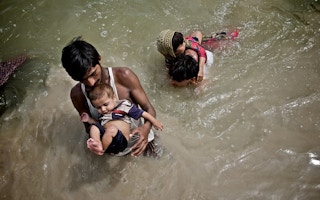Smashing homes and health facilities, while wiping out crops and flooding widespread areas, Cyclone Freddy, which hit southeast Africa in February and March of this year, was a preview into the future. In the worst-affected areas, people were using their bare hands to dig through rubble and mud, searching for survivors.
We are not reducing planet-heating emissions fast enough to stop climate change -and now we are faced with the daunting task of preparing for worst-case scenarios of increasingly extreme weather events.
To understand where the world stands in preventing such events from becoming disasters, the UN General Assembly mandated the midterm review of the implementation of the Sendai Framework for Disaster Risk Reduction, a key international agreement adopted in 2015 by 187 countries to reduce disaster losses by the year 2030.
Eight years into its implementation, many of the past disaster lessons seem to have been ignored and, as a report on the findings of the midterm review states, “progress has stalled and, in some cases, reversed.”
For example, while more and more countries have adopted national disaster risk reduction strategies, half of the world remains without early warning systems.
“
If we can limit the death and destruction from disasters, then we will be able to protect global progress towards the Sustainable Development Goals and adapt to our changing climate.
Intersecting crises
According to the report, there has been an 80 per cent increase in the number of people affected by disasters since 2015.
While the number of people affected was rising, disasters were becoming more complex and more expensive too, with an average above US$520 billion per year between 2015 and 2021, which is estimated to be significantly undervalued. At the same time, there has been no commensurate increase in funding for disaster risk reduction.
The Midterm Review points to a rapid accumulation of disaster risk that is building up and intersecting with other crises, such as increasing conflicts, growing poverty and deteriorating ecosystems.
In other words: disaster risk is spiralling out of control.
And as the world’s societies, technologies and environments have become hyperconnected, disasters can spread quickly and widely.
The Covid-19 pandemic began as a local outbreak in 2019 but spread around the world to kill 6.5 million people by the end of 2022 and send shockwaves through the global economy. Flooding in Pakistan last year affected more than 33 million people and damaged 4.4 million acres of agricultural land, an area the same size as the nation of Kuwait. This severely impacted food security and put increasing pressure on global agricultural markets.
These disasters tend to hit developing countries hardest. These are the countries that have contributed the least to creating the climate crisis and have the weakest defences and least resources for adaptation.
Progress on preparedness
There are areas of progress, including on data quality and analysis, and how countries are organizing themselves to adopt a prevention-oriented approach through national disaster risk reduction strategies. To date, 125 countries have reported developing such strategies. These support the development of strong and inclusive governance systems to manage disaster risk and their potential to cause a cascade of dangerous effects.
And there are examples to learn from. Costa Rica’s legislation allows for all institutions to allocate budgets for prevention and emergency response.
Australia’s Disaster Ready Fund invests up to A$200 million per year from 2023-2024 in disaster prevention and resilience initiatives. Barbados’ sovereign debt disaster clauses allow for an immediate debt moratorium in the event of an economic impact caused by a disaster.
Disaster preparedness has also advanced and is now more effective in saving lives. This is reflected in a decline in disaster-related mortality (barring the impact of Covid-19) from 1.77 per 100,000 global population in the decade 2005-2014 to 0.84 in the decade 2012-2021. A safer world is achievable. If countries invest the resources to understand and reduce risks, disasters can be prevented.
UN meeting
The challenge now is to accelerate progress to meet the scale of the challenge. The report captures several recommendations, which will be discussed over two days on May 18-19, at a high-level meeting of the UN General Assembly in New York. The recommendations include:
- Make all of government – from finance and planning to agriculture and energy – account for the real costs of disaster risks and incentivise prevention, moving away from single entity responsibility.
- Value resilience in our global financial system, including by addressing short-termism and market failures which neglect to factor disaster risks into investments.
- Guarantee the rights of all people to access disaster risk information and to participate in decision-making. Empowering women, persons with disabilities and Indigenous Peoples is crucial to counter deepening inequalities and diminishing civic spaces, which are increasing vulnerability and driving up humanitarian needs. Preventing disasters is a shared responsibility and right.
If we can limit the death and destruction from disasters, then we will be able to protect global progress towards the Sustainable Development Goals and adapt to our changing climate. If not, as we saw with Cyclone Freddy, a lot of progress could come undone.
Mami Mizutori is Special Representative of the UN Secretary-General for Disaster Risk Reduction and Head of the United Nations Office for Disaster Risk Reduction (UNDRR).
This story was published with permission from Thomson Reuters Foundation, the charitable arm of Thomson Reuters, that covers humanitarian news, climate change, resilience, women’s rights, trafficking and property rights. Visit https://www.context.news/.











